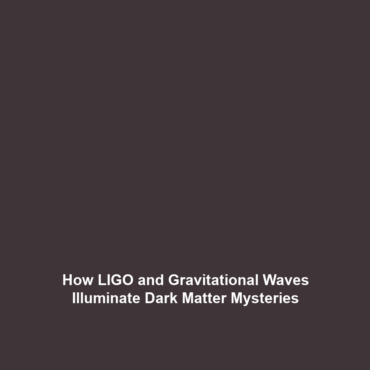The Role of LIGO and Gravitational Waves in Understanding Dark Matter
Introduction
The mysterious components of our universe, dark matter and dark energy, account for approximately 95% of the cosmos, yet remain largely undetectable through traditional methods. LIGO, the Laser Interferometer Gravitational-Wave Observatory, along with its ability to detect gravitational waves, is revolutionizing astrophysical research. This article examines the significance of LIGO and gravitational waves in understanding dark matter, shedding light on their pivotal roles within the broader context of dark matter and dark energy research. As scientists delve deeper into these cosmic phenomena, new insights are emerging, hinting at the potential for groundbreaking discoveries.
Key Concepts
To grasp the role of LIGO in elucidating dark matter, it is essential to understand some fundamental concepts.
Gravitational Waves
Gravitational waves are ripples in spacetime caused by some of the universe’s most violent and energetic processes, such as colliding black holes or neutron stars. LIGO was specifically designed to detect these waves, thereby providing a unique observational lens into the universe.
The Nature of Dark Matter
Dark matter is an invisible substance that does not emit, absorb, or reflect light, making it undetectable through conventional optical methods. Its existence is inferred from gravitational effects observed in galaxies and cosmic structures.
Applications and Real-World Uses
The intersection of LIGO’s discoveries and dark matter research is yielding several practical applications:
- Testing General Relativity: Gravitational waves provide empirical evidence that can confirm or challenge existing theories concerning dark matter.
- Mapping Cosmic Structures: Insights gained from gravitational wave detections contribute significantly to our understanding of the large-scale structure of the universe.
- Enhancing Detection Technologies: Techniques developed at LIGO could enhance sensors and imaging devices used in other scientific fields.
Current Challenges
Despite the progress made in utilizing LIGO and gravitational waves in dark matter research, several challenges persist:
- Calibration Issues: Ensuring the precision of gravitational wave detectors is paramount but challenging due to fluctuating environmental factors.
- Data Overload: The volume of data generated by LIGO can overwhelm current analytical methods, complicating the identification of significant events.
- Lack of Direct Detection: While gravitational waves provide information about cosmic events, they do not directly reveal the nature of dark matter.
Future Research and Innovations
Looking ahead, several innovations and research avenues are poised to enhance LIGO’s contributions to dark matter studies:
- Next-Gen Detectors: The development of advanced gravitational wave detectors with improved sensitivity and range could lead to detecting more faint events related to dark matter.
- Multi-Messenger Astronomy: By integrating data from gravitational waves with electromagnetic observations, researchers may gain a more comprehensive view of cosmic phenomena.
- Quantum Technologies: Innovations in quantum sensing may provide new means to enhance LIGO’s detection capabilities.
Conclusion
The role of LIGO and gravitational waves in understanding dark matter is increasingly significant within the broader framework of dark matter and dark energy. The ongoing research not only paves the way for future discoveries but also challenges our current understanding of the universe. As we move toward more advanced observational technologies, the potential for groundbreaking revelations about dark matter intensifies. For those interested in exploring this subject further, visiting resources on astrophysics and recent LIGO findings can provide deeper insights.

Leave a Reply